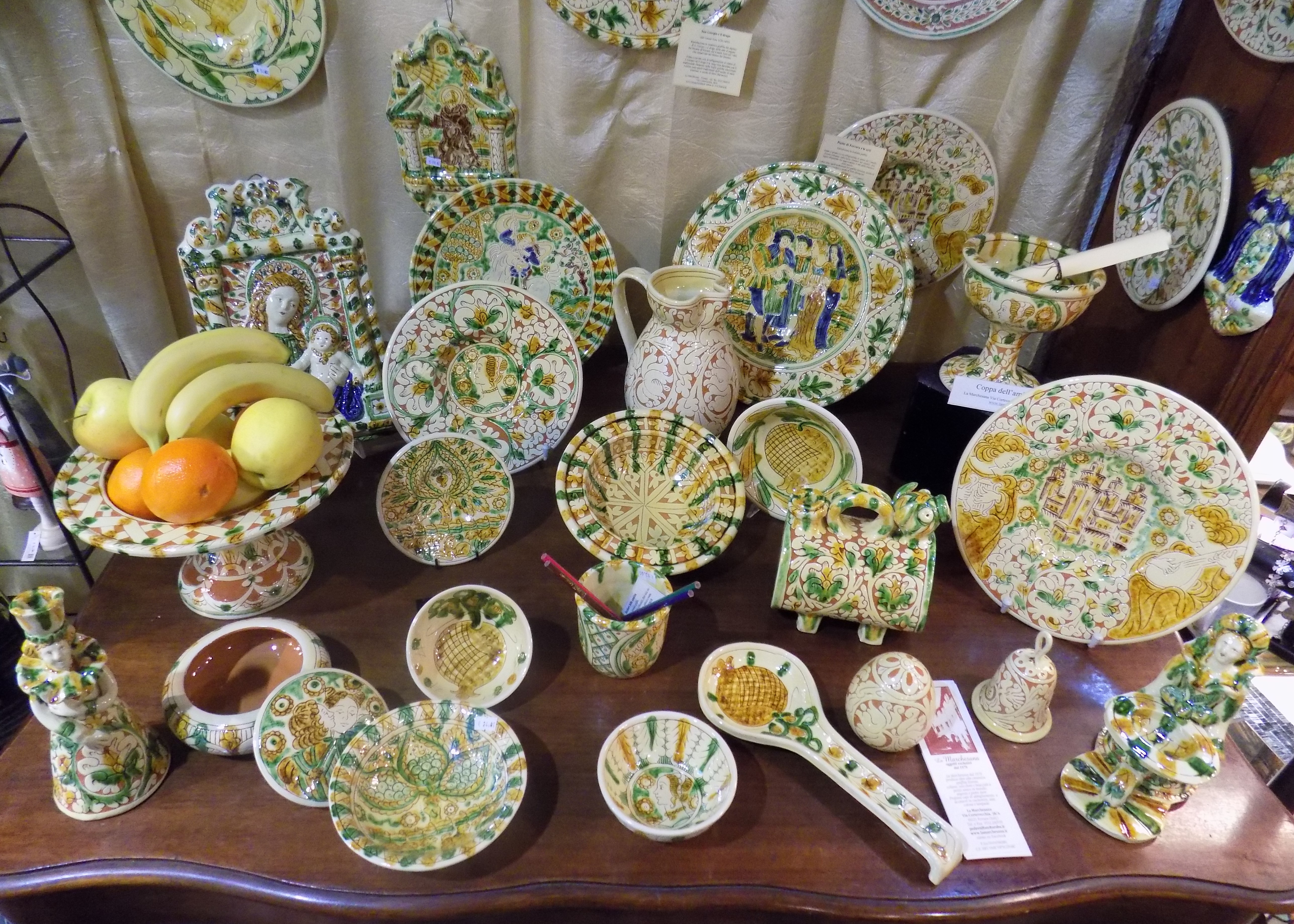
The history of Ferrara’s sgraffito ceramics traces its origins to early medieval artefacts from China and the vast areas of the Iranian Plateau, which arrived on Italian soil through maritime trade and commerce with the Orient.
The first works excavated by medieval archaeologists in Ferrara are dated no earlier than the thirteenth century and were a prelude to a highly important development during the fourteenth century, which achieved the highest standards of ornamentation and perfection in around 1440-1520.
During the initial or “archaic” stage of sgraffito pottery, the factories in the areas along the extensive Po valley produced artefacts with fairly uniform shapes and decoration. The clay of the Po valley lent itself particularly to the use of basic metal oxides - copper, iron and lead - for the paints that characterised this type of pottery.
The ornamental narratives are fairly standardised and mainly geometric and floral in nature; human figures appear much less frequently, although there also profiles of birds and pictures of imaginary animals borrowed from the bestiary of the time.
As a result of this production, whose influence spread even beyond the regions of northern Italy, Ferrara came to play a leading role and attain true primacy already from the first half of the fifteenth century, during the marquisate of Leonello d’Este.
The primordial spark was an extraordinary event for Este history and art: the Ecumenical Council of 1438. A session was held in Ferrara during that year, bringing to the city Pope Eugenius IV, the Byzantine Emperor John VIII Palaiologos, a multitude of great scholars and humanists and the extraordinary artist Antonio Pisano, known as Pisanello.
His work as a painter, medallist, and skilled draughtsman of animals, costumes and hairstyles, directly inspired the leading sgraffito ceramic shops of that period. Starting from those years, the most opulent tables of Ferrara began to be adorned with magnificent centrepiece bowls, large platters and side plates with edifying scenes, fine crockery decorated inside and out, inkwells featuring allegorical themes with coats of arms and, a little later, the recurring figure of St. George on horseback slaying the dragon in various different guises.
The accomplishments of the Este family and the coats of arms of the Rangoni, Bentivoglio, Bevilacqua, Romei, Contrari and Sacrati families and other such themes defined the decorations of many bowls, plates and tankards, evidently inspired by the most distinguished nobility of Ferrara at the time, even if the same heraldic motifs were also found and used on more common tables.
Production Area
Italian sgraffito pottery developed mainly in the northern regions, with certain differences according to time and place, from the fourteenth century until the end of the sixteenth century and beyond.
It was widely produced in Emilia, most notably in Ferrara.
This was the most active city and it produced the finest quality work, as seen in the remains of dishes and pots that have been found.
The Products
The engobed sgraffito ceramics were coloured with metal oxides, conferring rust and green effects, and then glazed during a second firing.
The forms were simple at first, including plates, bowls, dishes and tankards, although more complex objects such as cups and inkwells began to appear later, often decorated with contoured figurines of people and animals.
A variety of decorative motifs were used: the “knot”, which was an oriental talisman, the Star of David, which was a propitiatory sign, pomegranates, a circle with a cross, a diamond divided by a cross, animals, trees and good luck rosettes engraved in the background, together with heads, mostly in profile, and human or animal figures surrounded by leaves and Gothic scrolls.
Vegetative and geometric themes also appeared, at times covering the entire dish, and were often arranged in stripes and applied with a metal point or a stick.
The use of trellised hedges was particularly ornate.
These consist of interwoven willow branches enclosing a flower garden with female and male figures and coats of arms.
A garden enclosed by a trellis (“hortus conclusus”) represents a place of love and joy throughout the entire series known as “amatory” or “nuptial” ceramics.
Production
The objects are shaped on a wheel using red sedimentary clay.
A thin layer of smooth white clay (engobe) is spread on the raw object before it has fully dried.
The preparatory design is applied with a brush while the white clay is still damp, and then subsequently repeated, marking the surface of the white clay with a thin metal point to reveal the underlying grey clay, which becomes red after firing.
The most commonly used colours are verdigris (copper oxide), rust yellow (iron oxide) and manganese purple (manganese dioxide).
Before the second firing in the furnace the object is partially glazed (for waterproofing) with crystalline, which can either be clear or slightly coloured using the same metal oxides.
Interesting Facts
Duke Alfonso I d’Este is reputed to have been a great admirer of Ferrara sgraffito ceramics and in his spare time, when free from military or diplomatic duties, his passion for dabbling in his “workshop” in the Este castle was so great that it changed Italian aristocratic etiquette: he was the first prince to introduce ceramic tableware, which replaced the gold and silver that had been in use on the tables of nobility until then.
By Camera di Commercio di Ferrara with Unioncamere



